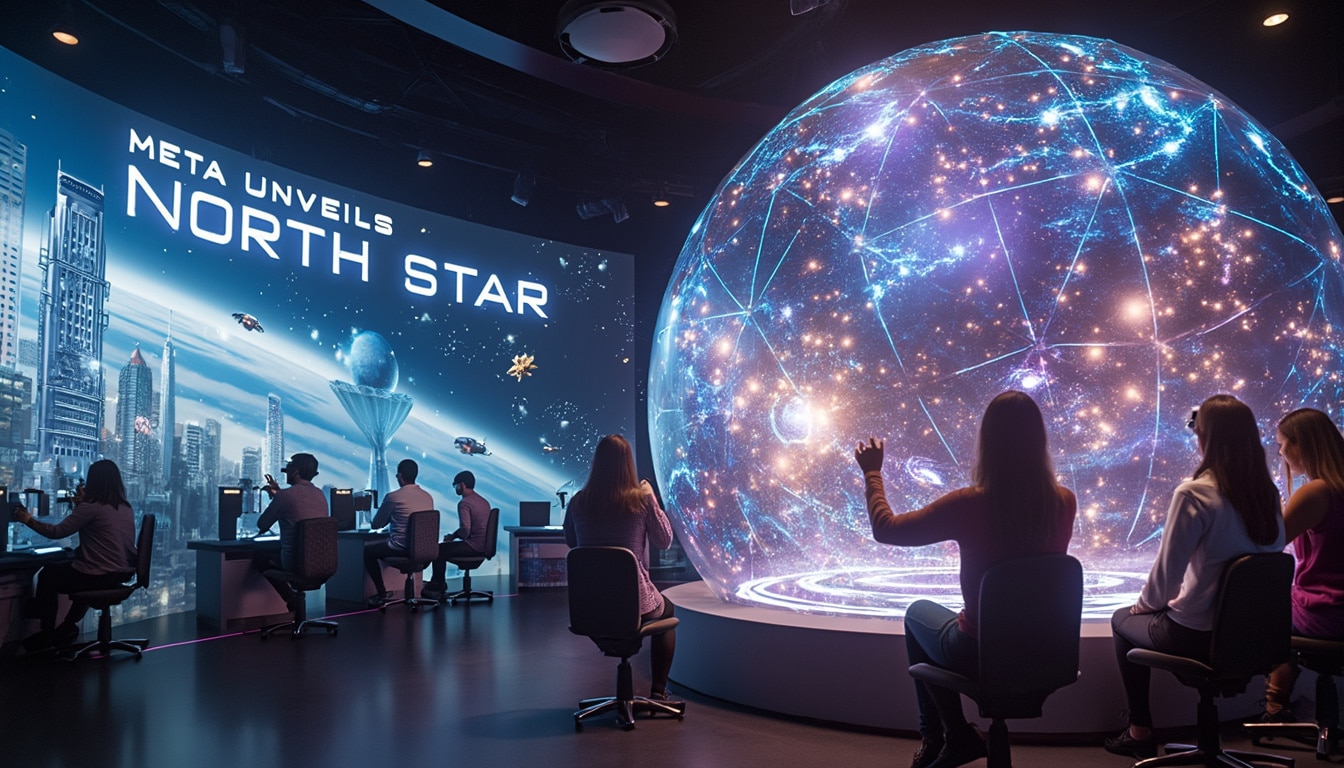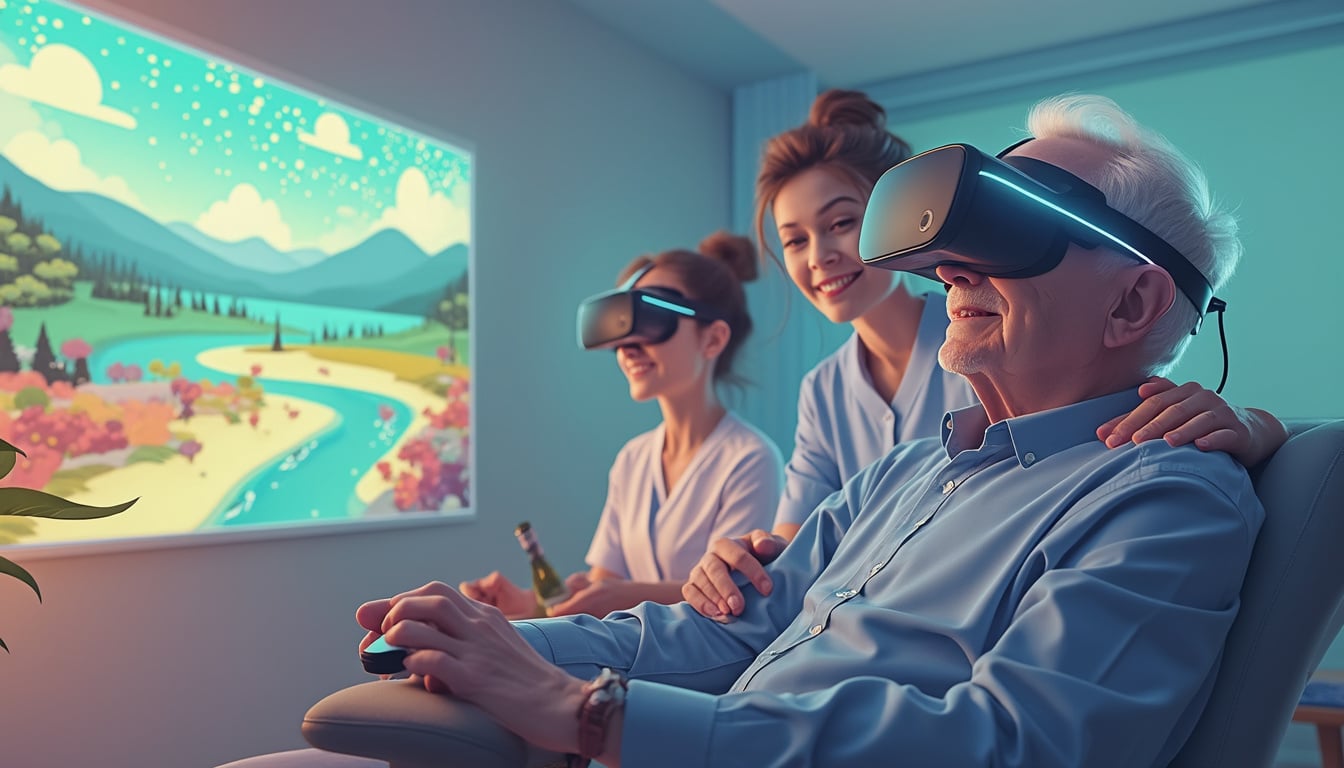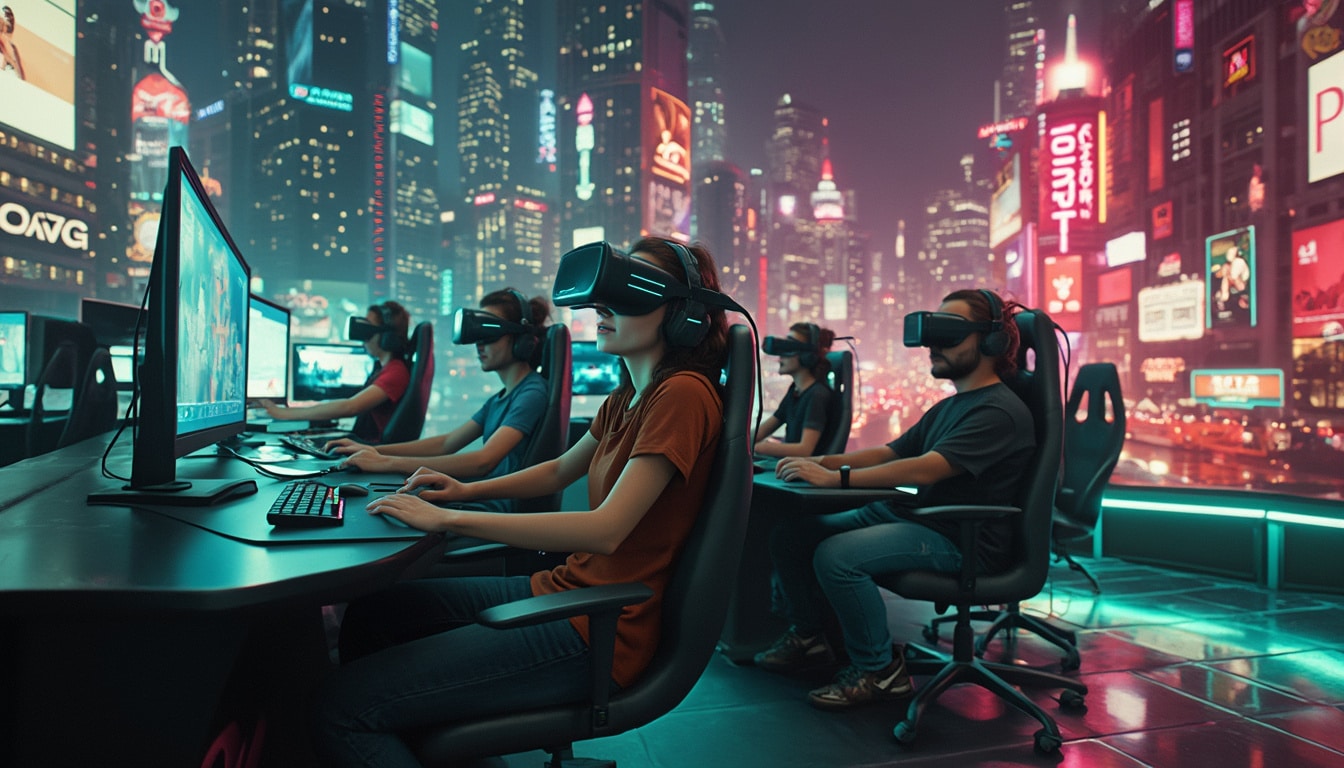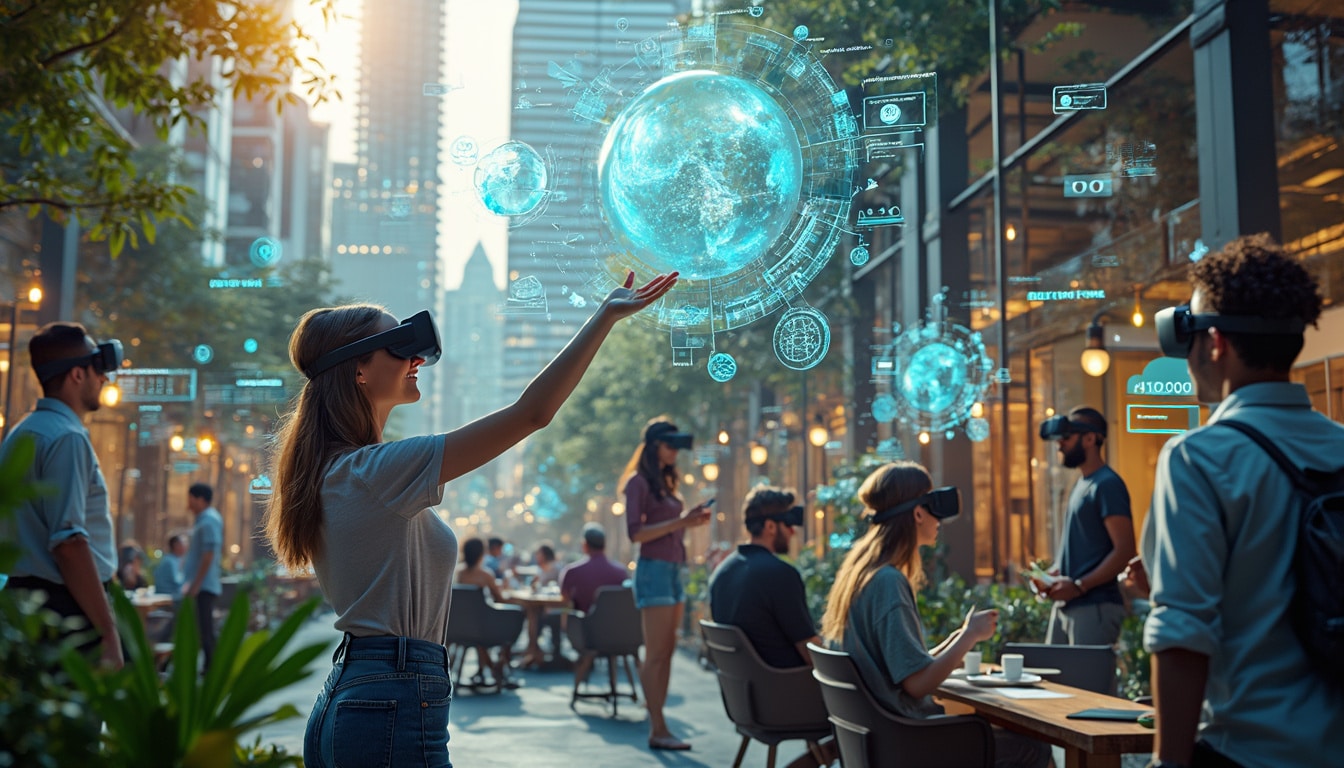« `html
Step into a world where virtual and reality coexist seamlessly. Experience the best of both without ever removing your headset. Welcome to the era of passthrough VR!
Virtual reality has always captivated us with its immersive experiences, yet it often isolates us from our surroundings. Passthrough technology transforms this by allowing users to glimpse the real world through their VR headsets. This fusion of virtual and real elements makes VR not only safer but also more intuitive and versatile. Let’s explore how passthrough is changing the everyday VR landscape.
Passthrough VR is a groundbreaking technology that lets you see the real environment without taking off your headset. By utilizing external cameras, the VR device captures live footage of your surroundings and displays it within the headset’s screens. This creates the illusion of looking through the device, offering a live video feed of the real world. This setup keeps you connected to your physical environment while interacting with digital elements, laying the foundation for what’s known as mixed reality.
While often confused with mixed reality and optical augmented reality, passthrough VR stands apart. In passthrough, your view of the real world is mediated by video capture, meaning what you see is a video rendition rather than a direct view. On the other hand, optical transparency allows direct sight through transparent lenses, similar to augmented reality glasses. Mixed reality involves dynamic interactions between physical and virtual objects, creating a more integrated experience.
Before passthrough technology, donning a VR headset meant disconnecting entirely from your environment. You couldn’t see objects on your table or interact naturally with people nearby. Passthrough removes this barrier by making the real world visible within the headset, allowing physical objects to serve as platforms for virtual elements. A wall could become an interactive interface, and a real table might host a digital keyboard. This blending of realities makes experiences more intuitive and paves the way for genuine mixed reality.
The magic behind passthrough lies in the coordination of cameras, sensors, and sophisticated algorithms. Front-facing cameras capture your environment in real-time, and the VR software processes these images for stereoscopic display. This includes correcting optical distortions, aligning visuals with head movements, and sometimes overlaying digital markers. Minimizing latency is crucial to maintain immersion and prevent visual discomfort, ensuring that the passthrough experience feels natural.
Not all passthrough systems are created equal. The quality hinges on factors like camera resolution, color accuracy, refresh rates, and latency. For instance, the Meta Quest 2 offers a black-and-white passthrough mode adequate for obstacle detection but limited for precise interactions. In contrast, devices like the Meta Quest 3S and Apple Vision Pro provide high-definition color passthrough, delivering smoother and more realistic visuals. This leap in quality shifts usage from mere utility to an immersive window into the real world.
Passthrough VR goes beyond visualization; it enables interactive experiences between the physical and virtual realms. Imagine placing a real object, like a controller or a cup, on a virtual table within your headset. The spatial alignment is so accurate that real and digital elements appear to coexist naturally. This level of interaction is a significant step towards truly fluid and coherent mixed reality environments.
Advanced passthrough capabilities transform VR headsets into hybrid workspaces or creative hubs. Users can see their physical desks while manipulating virtual windows, 3D objects, or design tools. This overlay keeps you grounded in your real environment while harnessing the creative power of digital tools. In gaming, it allows for intuitive interactions with both physical and virtual objects, making immersion contextual and enriching by integrating the real into the virtual.
Today, passthrough VR has practical applications that enhance safety and comfort at home. It lets users navigate their living spaces without removing the headset, avoiding furniture and obstacles effortlessly. This feature also boosts comfort during long VR sessions by allowing quick glances at real objects like controllers or beverages without breaking immersion. Passthrough turns VR headsets from isolated gadgets into adaptive devices that incorporate the physical world into daily use.
In professional settings, passthrough revolutionizes remote interactions. Virtual meetings become more natural as participants can see their physical spaces and integrate real objects into the digital environment. This enhances communication and collaboration on shared projects, reducing the fatigue associated with prolonged headset use. The hybrid environments created by passthrough offer a richer, more immersive experience where work, social interaction, and reality blend seamlessly.
Despite its advancements, passthrough VR still faces challenges. The video-based perception doesn’t yet match natural vision quality, often showing distortions, slight blurs, or reduced depth perception. Some systems display in black and white, limiting detail recognition. Additionally, minor delays between real movements and their video display can disrupt the sense of transparency. In bright or complex settings, the passthrough view remains imperfect for fine tasks.
The technology demands high performance from VR headsets, as real-time video capture, processing, and 3D display are resource-intensive. This can drain batteries quickly and cause overheating during extended use. Privacy is another concern, as continuous camera use means your environment is always being recorded. These issues prevent passthrough from fully replacing traditional interfaces, but they do open up exciting new possibilities for how we use VR.
Not all VR headsets come equipped with passthrough capabilities. Only models with front-facing cameras can offer this feature. Older or entry-level headsets, such as certain PC VR models, might lack passthrough technology. However, most modern devices like the Meta Quest 2, Quest 3, HTC Vive XR Elite, and Apple Vision Pro include varying levels of passthrough quality, depending on their built-in sensors and software processing.
Users have the flexibility to toggle passthrough on or off based on their needs. Typically, passthrough activates automatically when leaving the play area or through specific gestures like a double-tap on the headset. Some devices allow continuous passthrough use for mixed reality applications. If full immersion is desired without real-world distractions, users can disable passthrough in the settings to enjoy a completely virtual experience.
There are two types of passthrough: passive and active. Passive passthrough simply displays the real world through the headset’s cameras without any interaction with the captured elements. It’s mainly used for orientation and obstacle detection. Active passthrough, however, involves interaction layers where real objects are recognized and integrated into the virtual environment. For example, you might see your physical keyboard and use it to type within a virtual interface. Active passthrough is essential for creating a more immersive and context-aware mixed reality experience.
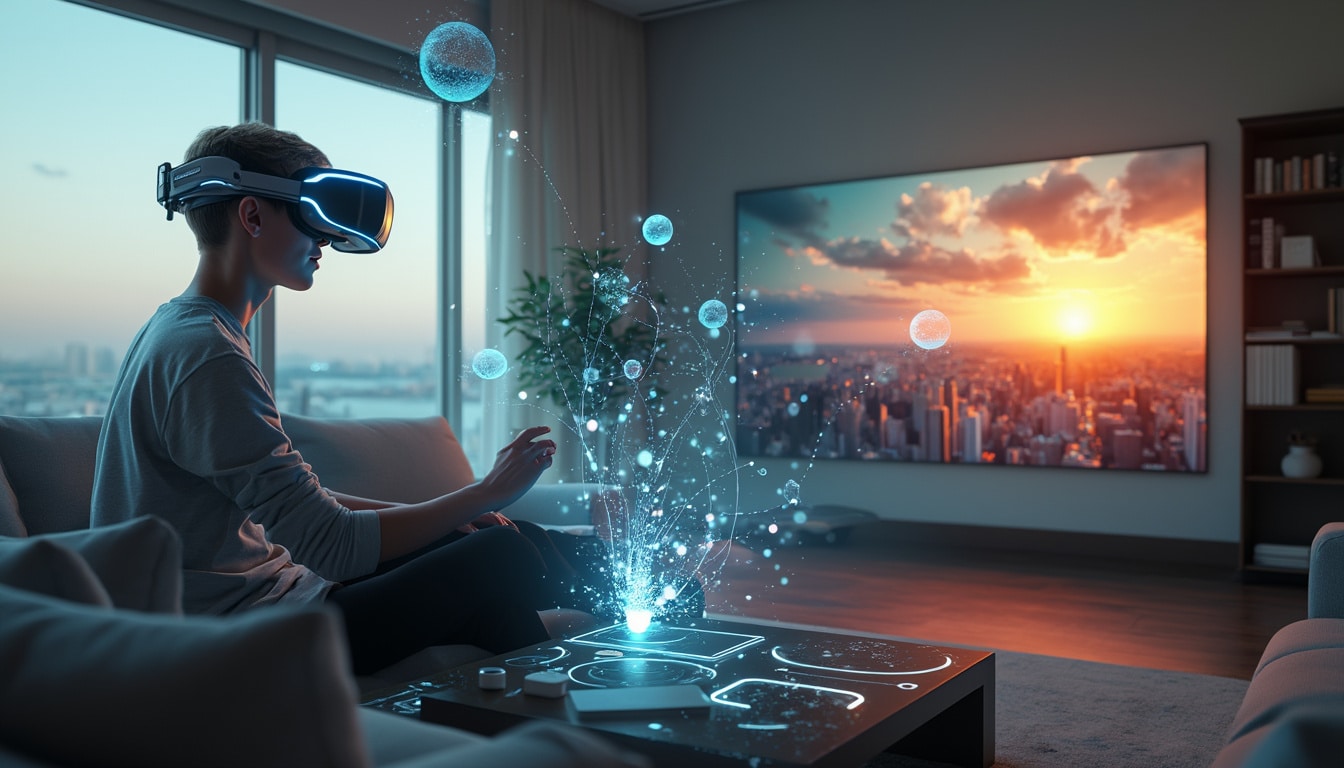
Table of contents
Togglewhat is passthrough and how is it reshaping vr
Imagine diving into a virtual world without completely disconnecting from reality. Sounds like something out of a sci-fi movie, right? Well, welcome to the era of PassThrough VR! This game-changing technology bridges the gap between the virtual and the real, allowing you to experience immersive environments while still keeping an eye on your living room chaos. Gone are the days of stumbling over your cat or accidentally knocking over a cup of coffee because your VR headset blindsided you from the real world. With PassThrough, you get the best of both worlds—virtual adventures without the real-world mishaps.
PassThrough technology utilizes external cameras on your VR headset to capture your surrounding environment in real-time. These images are then seamlessly integrated into your virtual experience, creating a hybrid space where digital and physical elements coexist. Whether you’re gaming, working, or exploring, PassThrough ensures you remain connected to your physical space, enhancing both safety and convenience. It’s like having a window into reality while being fully immersed in a digital realm.
This fusion of virtual and real-world elements not only amplifies the immersive experience but also paves the way for innovative applications. From virtual meetings where you can see your actual desk to games that interact with your room’s layout, PassThrough is revolutionizing how we interact with VR. It’s a subtle yet powerful shift that transforms VR from an isolated escapade into a seamlessly integrated extension of our daily lives.
how passthrough differs from mixed and augmented reality
While PassThrough VR, mixed reality, and augmented reality might sound like members of the same futuristic family, they each bring something unique to the table. PassThrough primarily focuses on integrating the real world into the VR experience through video feed, allowing users to see their actual environment without removing the headset. This method relies on external cameras to capture and display the physical world within the virtual space.
On the other hand, mixed reality (MR) takes things a step further by enabling dynamic interaction between real and virtual objects. In MR, digital elements aren’t just overlays; they can interact with the physical environment in real-time. For example, a virtual object might sit on your real table or respond to your movements, creating a more cohesive and interactive experience.
Meanwhile, augmented reality (AR) typically uses transparent displays or lenses to overlay digital information onto the real world. Unlike PassThrough, which provides a video-based view, AR maintains a direct view of the real environment, allowing for more natural interactions without the intermediary of video feeds.
In essence, while PassThrough VR offers a way to blend the real with the virtual through video integration, mixed reality and augmented reality provide more interactive and transparent ways to enhance the real world with digital overlays and interactions. Each technology has its own set of strengths, making them suitable for different applications and user experiences.
how passthrough enhances safety and convenience in vr
One of the standout benefits of PassThrough VR is its ability to enhance safety without compromising the immersive experience. Traditional VR setups often leave users vulnerable to real-world hazards, such as tripping over furniture or bumping into walls. PassThrough solves this problem by allowing users to see their physical environment while still enjoying a virtual experience. This means you can navigate your space confidently, knowing exactly where your surroundings are.
Moreover, PassThrough adds a layer of convenience by eliminating the need to constantly remove the headset to interact with the real world. Need to grab a snack, adjust your seating, or take a quick call? With PassThrough, simply switch your view within the headset without breaking your immersion. This seamless transition between virtual and real eliminates interruptions that can detract from the overall experience.
In practical terms, this technology is a boon for extended VR sessions, reducing eye strain and physical discomfort. Users can take frequent glances at their surroundings, maintaining awareness and comfort without fully leaving the virtual environment. Additionally, PassThrough can enhance productivity by integrating real-world tools and objects into virtual workspaces, allowing for a more intuitive and efficient workflow.
From gaming to professional applications, the safety and convenience offered by PassThrough make VR more accessible and user-friendly. It transforms VR from a solitary escape into a versatile tool that harmonizes with your everyday life, ensuring that you can enjoy immersive experiences without the usual drawbacks.
technical workings of passthrough in vr
Diving into the technical side, PassThrough VR operates through a sophisticated interplay of cameras, sensors, and software algorithms. The foundation of PassThrough is the use of external cameras mounted on the VR headset. These cameras continuously capture the user’s real-world environment, creating a live video feed that is then processed in real-time.
Once the video is captured, the headset’s software takes over, enhancing the footage by correcting any optical distortions and aligning it with the user’s head movements. This ensures that the passthrough view remains stable and synchronized with the virtual experience, providing a realistic and seamless integration of real and virtual elements. The processed video is then displayed on the headset’s internal screens, allowing users to see their actual surroundings without lifting the headset.
The magic happens in the low-latency processing of these video feeds. Minimizing the delay between capturing the real world and displaying it in the headset is crucial for maintaining immersion and preventing motion sickness. Advanced algorithms work tirelessly to reduce latency, ensuring that the passthrough view is as instantaneous and smooth as possible.
Additionally, some PassThrough systems incorporate depth sensors and machine learning techniques to enhance the interaction between the real and virtual worlds. These technologies enable the recognition of objects and spatial awareness, making it possible to anchor virtual elements to physical locations accurately. The result is a cohesive and interactive mixed reality experience where digital and real-world objects coexist harmoniously.
quality matters: color, resolution, and latency in passthrough vr
Not all PassThrough implementations are created equal. The quality of PassThrough hinges on several critical factors: color fidelity, resolution, and latency. These elements collectively determine how natural and immersive the passthrough experience feels.
Color and resolution play a significant role in ensuring that the real world appears as lifelike as possible within the virtual environment. High-resolution cameras and displays can capture and render detailed and vibrant images, making virtual overlays appear more realistic. For instance, the Meta Quest 3S and the Apple Vision Pro offer high-definition color passthrough, providing a crisp and vivid view of the user’s surroundings. In contrast, devices like the Meta Quest 2 might offer lower-resolution, black-and-white passthrough, which is primarily functional but less visually appealing.
Latency is another crucial factor. High latency can disrupt the seamless integration of real and virtual worlds, leading to a disjointed experience and even motion sickness. Effective PassThrough systems strive to minimize latency by optimizing processing speeds and using advanced algorithms. Lower latency ensures that movements in the real world are instantly reflected in the virtual environment, maintaining immersion and reducing visual discomfort.
Moreover, the refresh rate of the passthrough display affects how smooth the visual experience feels. Higher refresh rates contribute to more fluid transitions and interactions, making the integration of real and virtual elements feel more natural. As technology advances, we can expect passthrough quality to continue improving, offering increasingly realistic and immersive VR experiences.
In summary, the quality of PassThrough VR is determined by the interplay of color accuracy, resolution, and latency. High-quality passthrough not only enhances visual realism but also ensures a comfortable and immersive user experience, setting the stage for more advanced mixed reality applications.
how passthrough enables interactive mixed reality experiences
PassThrough VR isn’t just about seeing the real world; it’s about interacting with it in meaningful ways. This technology lays the groundwork for truly interactive mixed reality experiences, where digital and physical elements can coexist and interact seamlessly. Imagine having a virtual keyboard appear on your real desk or seeing holographic characters interact with your actual surroundings—that’s the power of PassThrough.
One of the key innovations enabled by PassThrough is the ability to anchor virtual objects to real-world locations. By using spatial recognition and precise tracking, virtual elements can be positioned and interacted with as if they were part of the physical environment. For example, you could place a virtual monitor on your real table and use your actual keyboard to type, blending the digital and physical seamlessly.
PassThrough also enhances collaborative experiences. In virtual meetings, participants can share their physical workspace alongside virtual presentations, making interactions more natural and engaging. This blending of real and virtual spaces fosters a more dynamic and productive collaboration, as users can manipulate both physical and digital objects within the same environment.
In gaming, PassThrough allows for innovative gameplay mechanics where players can interact with their real environment in conjunction with virtual challenges. This hybrid approach not only enriches the gaming experience but also opens up new possibilities for game design and interactivity.
The integration of real and virtual elements through PassThrough represents a significant leap towards a more immersive and interactive VR experience. It transforms VR from a purely digital escape into a versatile platform that enhances and interacts with the real world, offering endless possibilities for creativity, productivity, and entertainment.
practical applications of passthrough in everyday life
The versatility of PassThrough VR extends far beyond gaming and entertainment. Its ability to merge the real and virtual worlds opens up a plethora of practical applications that can enhance various aspects of daily life.
In the realm of telework and collaboration, PassThrough enables virtual meetings where participants can share their physical workspace alongside digital presentations. This creates a more natural and engaging interaction, allowing colleagues to easily reference real-world objects or documents without switching between different platforms. It also reduces the fatigue associated with prolonged headset use by providing moments of real-world visibility.
For creative professionals, PassThrough offers a hybrid workspace where physical tools and digital assets can coexist. Designers can sketch on real paper while simultaneously viewing and manipulating their digital models within the same space. This seamless integration fosters creativity and efficiency, making it easier to switch between physical and digital tasks.
In education and training, PassThrough can revolutionize the learning experience by providing interactive and immersive environments. Students can engage with virtual simulations while still observing their physical surroundings, enhancing understanding and retention of complex concepts. Similarly, professionals in fields like medicine or engineering can benefit from hands-on training that integrates real equipment with virtual instructional content.
PassThrough also enhances home automation and smart living. Imagine controlling smart appliances and devices through a virtual interface while still being able to see their physical counterparts. This integration makes managing your home more intuitive and efficient, blending the convenience of digital controls with the familiarity of your physical environment.
From enhancing workplace productivity to enriching educational experiences and smart living, PassThrough VR is proving to be an indispensable tool in bridging the gap between the digital and physical worlds, making it an integral part of everyday life.
real-world examples of passthrough vr applications
To truly grasp the impact of PassThrough VR, let’s look at some real-world examples that showcase its versatility and potential. One notable example is the Meta Quest series, specifically the latest updates enhancing the Quest 3S’s computing capabilities. These advancements allow for higher resolution passthrough views and more responsive interactions, making the virtual and real seamlessly blend together [Read more].
Another exciting development is Samsung’s first Android XR headset, which integrates advanced passthrough features to offer a more immersive mixed reality experience. The design focuses on comfort and functionality, enabling users to transition effortlessly between virtual and real-world interactions [Read more]. This headset represents a significant step forward in making mixed reality a practical tool for both personal and professional use.
In education, platforms like Engage are utilizing PassThrough to create interactive virtual classrooms. Teachers can present digital content while still being able to monitor and interact with their physical classroom environment, enhancing the learning experience for students by making it more dynamic and engaging.
In the medical field, PassThrough VR is being used for surgical training and simulations. Surgeons can practice procedures in a virtual environment while still referencing real surgical tools and equipment, providing a comprehensive training tool that bridges theoretical knowledge with practical skills.
These examples illustrate how PassThrough VR is not just a theoretical concept but a practical technology that is being actively integrated into various industries. Its ability to blend the virtual and real worlds opens up new possibilities for innovation and efficiency across different sectors.
the future of mixed reality: beyond passthrough
As PassThrough VR continues to evolve, the future of mixed reality holds even more exciting possibilities. The current capabilities are just the beginning, with advancements in technology paving the way for more immersive, interactive, and seamless experiences. One of the key areas of development is the integration of artificial intelligence and machine learning with PassThrough, enabling more intelligent and adaptive interactions between the virtual and real worlds.
Imagine a mixed reality environment where virtual objects can intelligently respond to changes in the physical environment, adapting their behavior based on real-time data. This could lead to more intuitive user interfaces, smarter virtual assistants, and enhanced interactive experiences that anticipate and respond to your needs.
Another promising development is the enhancement of haptic feedback systems. Combining PassThrough with advanced haptic technology could create a more tactile and realistic interaction with virtual objects. Users might not only see and hear digital elements but also feel them, adding a new dimension to the VR experience.
Moreover, the expansion of wireless and standalone VR headsets will further enhance the portability and accessibility of mixed reality experiences. As headsets become lighter, more comfortable, and require less tethering to external devices, users will enjoy a more seamless and immersive experience, whether they are at home, in the office, or on the go.
Looking ahead, the convergence of PassThrough VR with other emerging technologies like augmented reality glasses and advanced sensors will create a more integrated and fluid digital ecosystem. This ecosystem will enable users to transition effortlessly between different types of reality-based interactions, making mixed reality an integral part of everyday life.
The future of mixed reality is bright, with PassThrough VR playing a pivotal role in shaping how we interact with digital and physical worlds. As technology advances, we can expect even more innovative applications and experiences that push the boundaries of what’s possible, making mixed reality an indispensable tool for creativity, productivity, and entertainment.
common challenges and limitations of passthrough vr
While PassThrough VR offers numerous benefits, it also comes with its own set of challenges and limitations that need to be addressed for it to reach its full potential. Understanding these obstacles is crucial for developers and users alike as they navigate the evolving landscape of virtual and mixed reality technologies.
One of the primary challenges is the quality of the passthrough view. Even with high-resolution cameras, the video feed can sometimes appear distorted or suffer from lag, disrupting the seamless integration of real and virtual elements. Low-resolution or black-and-white passthrough, as seen in some older headsets, limits the user’s ability to perceive detailed and accurate representations of their environment, reducing the overall effectiveness of the mixed reality experience.
Another significant limitation is latency. High latency can lead to a disconnect between the user’s movements and the passthrough display, causing motion sickness and breaking immersion. Achieving low latency requires advanced processing capabilities and efficient data transmission, which can be challenging to implement without compromising other aspects of the VR experience.
Hardware constraints also pose a hurdle. PassThrough VR requires robust hardware, including high-resolution cameras and powerful processing units, which can make headsets more expensive and less accessible to the average consumer. Additionally, the increased demand for power can lead to shorter battery life and more frequent recharging, limiting the practicality of prolonged use.
Privacy concerns are another critical issue. PassThrough involves continuous video capture of the user’s environment, raising questions about data security and privacy. Users may be uncomfortable with the idea of their lived spaces being recorded and processed, especially in sensitive or personal settings. Ensuring that passthrough data is handled securely and transparently is essential to gaining user trust and widespread adoption.
Finally, the integration of PassThrough with existing virtual environments is still in its infancy. Developing applications that effectively blend real and virtual elements requires significant innovation and collaboration between hardware manufacturers and software developers. As the technology matures, these challenges will likely be addressed, but for now, they represent significant barriers to the widespread adoption of PassThrough VR.
answers to frequently asked questions about passthrough vr
Is passthrough available on all vr headsets?
No, not all virtual reality headsets come equipped with passthrough capabilities. Only those models that feature external cameras, such as the Meta Quest 2, Quest 3, HTC Vive XR Elite, and the Apple Vision Pro, offer passthrough functionality. Older or entry-level VR headsets may lack the necessary hardware to support passthrough, limiting their ability to integrate real-world views into the virtual experience.
Can you turn off passthrough?
Yes, most VR headsets with passthrough capabilities allow users to enable or disable this feature based on their preferences. Users can typically toggle passthrough on or off through the headset’s settings menu or use specific gestures, such as a double-tap on the device, to switch modes. This flexibility allows users to choose between a fully immersive virtual experience and a mixed reality setup that integrates their real-world environment.
What is the difference between active and passive passthrough?
Passive passthrough involves displaying the real-world environment through the headset’s cameras without any additional interaction or integration. It’s primarily used for situational awareness, helping users navigate their physical space without making any changes to the virtual experience.
In contrast, active passthrough goes a step further by enabling interaction between real and virtual objects. This means that the real-world environment can influence the virtual elements, allowing for a more dynamic and interactive mixed reality experience. For example, users can place real objects within their virtual workspace and interact with them as if they were part of the digital environment.
Active passthrough is essential for creating a truly interactive mixed reality experience, where the boundaries between the digital and physical worlds are seamlessly blended.
What are the privacy implications of using passthrough?
PassThrough VR involves continuous video capture of the user’s environment, which raises significant privacy concerns. The constant recording can potentially expose personal or sensitive information, leading to risks of data breaches or unauthorized access. To mitigate these concerns, it’s crucial for headset manufacturers and software developers to implement robust security measures. This includes encrypting data, providing clear privacy policies, and allowing users to control when and how their environment is recorded. Users should also be aware of the permissions they grant to VR applications and ensure their devices are secured against unauthorized access.
How does passthrough impact battery life?
Using PassThrough significantly increases the demand on a VR headset’s hardware, particularly the cameras and processing units. This heightened usage can lead to a faster drain on the device’s battery, reducing the overall battery life during VR sessions. To address this, some headsets are equipped with larger batteries or optimized power management systems to extend usage time. However, users should be mindful of the increased power consumption and plan for shorter sessions or have access to charging options when using passthrough frequently.
Can passthrough be used for productivity applications?
Absolutely! PassThrough enhances productivity applications by allowing users to interact with their real-world environment while working within a virtual space. For instance, users can reference physical documents, use real keyboards, or interact with other tangible tools without leaving the VR environment. This integration streamlines workflows and makes virtual workspaces more practical and efficient, blending the best of both worlds to enhance overall productivity.









